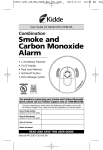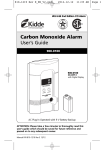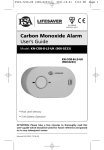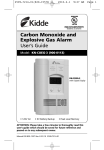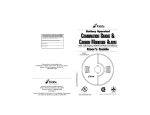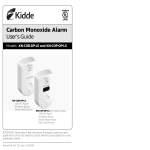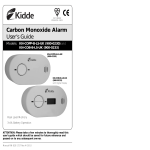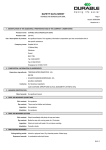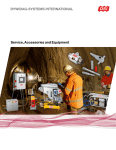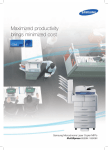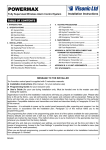Download Kidde KN-COU-B User's Manual
Transcript
2541-7201-01_revB_EN_V1:_ 2013.3.5 11:13 AM Carbon Monoxide Monitor User Guide Model: KN-COU-B • • • • Peak Level Memory Digital Display Detects Low Levels of Carbon Monoxide 3-AA Battery Operation ATTENTION: Please take a few minutes to thoroughly read this user guide which should be saved for future reference and passed on to any subsequent owner. Manual P/N 2541-7201-01 Rev.B 06/12 EN Page 1 2541-7201-01_revB_EN_V1:_ 2013.3.5 11:13 AM What to do When the Monitor Sounds! Carbon Monoxide Monitor Procedure WARNING: Full monitor activation indicates the presence of Carbon Monoxide (CO) at high concentrations, which can kill you. 1) Operate the Test/Reset button; 2) Call your emergency services (Fire Department or 911); PHONE NUMBER: 3) Immediately move to fresh air - outdoors or by an open door/window. Do a head count to check that all persons are accounted for. Do not reenter the premises nor move away from the open door/window until the emergency services responders have arrived, the premises have been aired out, and your monitor remains in its normal condition. 4) After following steps 1-3, if the monitor reactivates within a 24 hour period, repeat steps 1-3 and call a qualified appliance technician to investigate sources of CO from fuel burning equipment and appliances, and to inspect for proper operation of equipment. PHONE NUMBER: If problems are identified during this inspection, have the equipment serviced immediately. Note any combustion equipment not inspected by the technician and consult the manufacturer’s instructions, or contact the manufacturer’s directly for more information about CO safety and the equipment. Make sure that motor vehicles are not, or have not been, operating in a garage attached or adjacent to the residence. Never restart the source of a CO problem until it has been corrected. Never ignore the sound of the monitor! If the unit is sounding, pressing the test/reset button will terminate the monitor. If the CO condition that caused the alert in the first place continues, the unit will reactivate in alert or full alarm mode. If the unit goes into full alarm again within six minutes, it is sensing high levels of CO which can quickly become a dangerous situation. Page 2 2541-7201-01_revB_EN_V1:_ 2013.3.5 11:13 AM Carbon Monoxide Alert Procedure Low Level Alert WARNING: Alerts to the presence of constant low level CO concentrations (less than 30 ppm). These constant low levels may pose potential health risks for individuals with certain pre-existing health or medical conditions. You must consult your health care provider as to any potential low level CO exposure risk due to any specific pre-existing heath or medical conditions. 1) Operate the Test/Reset button; 2) If a constant low level of Carbon Monoxide (below 30 ppm) is measured and persists in your home you should consult your healthcare giver about the long term impact on your health. 3) Move all occupants to fresh air to avoid any immediate health repercussions. 4) After following steps 1-3, if the unit goes into full alarm follow the Carbon Monoxide Monitor Procedure for response and evacuation. If the unit is sounding, pressing the test/reset button will terminate the notification. If the CO condition that caused the alert in the first place continues, the unit will reactivate in alert or full alarm mode. If the unit goes into full alarm again within six minutes, it is sensing high levels of CO which can quickly become a dangerous situation. This CO monitor operates differently than CO and smoke alarms. Like smoke and CO alarms, this CO monitor samples the air in your home and sounds a loud alarm to warn you of life threatening conditions. In addition, this monitor will alert you to lingering low levels of CO (below 30 ppm) which may have heath implications if you suffer from certain pre-existing health or medical conditions. You should discuss your specific needs for a low level CO monitor with your healthcare provider to determine if a low level CO monitor is warranted given a particular preexisting medical or health condition. The way you respond to a CO alarm is quite different than a smoke alarm. That’s because a house fire and a CO problem are two distinctly different situations. If your smoke alarm were to alarm, you would quickly be able to judge the level of danger you were in with your senses. You can see and smell the smoke, feel the heat, see, and possibly hear the fire burning. You can also readily see if your smoke alarm is alarming in a non-emergency situation. Because your sense of sight, smell, hearing and touch give you information, you can almost instantly judge what action to take if you hear your smoke alarm. Page 3 2541-7201-01_revB_EN_V1:_ 2013.3.5 11:13 AM This Kidde carbon monoxide (CO) monitor is part of your family’s health monitoring and safety plan. This monitor has been designed and tested to detect and alert to the presence CO background concentrations which can emanate from several sources including heating appliances, automobile traffic, and pollution. The monitor is also capable of detecting and alarming in response to a rapid buildup of carbon monoxide from malfunctioning appliances and equipment (ovens, heaters, generators, etc.) leading to unsafe conditions. Your monitor is for use specifically in the home. As an owner of a CO monitor, there are some basic facts you should know for your protection. Important Warning Statements WARNING: This product is intended for use in ordinary indoor locations of family living units. It is not designed to measure compliance with Occupational Safety and Health Administration (OSHA), commercial or industrial standards. It is not suitable for installation in hazardous locations as defined in the National Electric Code. CO is an invisible, odorless, tasteless and non-irritating gas – completely undetectable to your senses. IMPORTANT: This carbon monoxide monitor is designed to detect carbon monoxide from ANY source of combustion. It is NOT designed to detect smoke, fire, or any other gas. This carbon monoxide monitor cannot be used to meet code requirements which require the installation of a CO alarm which complies with the alarm requirements set forth in Underwriter’s Laboratory standard 2034 (UL 2034). WARNING: Carbon monoxide monitors and alarms are not smoke alarms. This carbon monoxide monitor is not a substitute for installing and maintaining an appropriate number of smoke alarms in your home. This carbon monoxide monitor will not sense smoke, fire, or any poisonous gas other than carbon monoxide even though carbon monoxide can be generated by fire. For this reason you must install smoke alarms to provide early warning of fire and to protect you and your family from fire and its related hazards. The installation of this device should not be used as a substitute for proper installation, use and maintenance of fuel burning appliances, including appropriate ventilation and exhaust systems. It does not prevent CO from occurring, nor can it solve an existing CO problem. Page 4 2541-7201-01_revB_EN_V1:_ 2013.3.5 11:13 AM CAUTION: This monitor will only indicate the presence of carbon monoxide at the sensor. Carbon monoxide may be present in other areas. WARNING: This device is designed to alert and provide information to individuals to the presence of low concentrations (below 30ppm) of carbon monoxide. This information may provide additional protection to individuals with specific pre-existing medical conditions which may make them vulnerable to the presence of low concentrations (below 30 ppm) of carbon monoxide. Individuals with potential extreme sensitivities to low CO concentrations due to pre-existing medical and health conditions should consult their health care provider to determine the benefits which may be provided by a low level CO monitor. This carbon monoxide monitor requires a continuous supply of electrical power – it will not work without power. This monitor has been investigated for carbon monoxide detection below 70 PPM. Contents of This User Guide 1. Information About Carbon Monoxide 2. Product Features and Specifications 3. Installation Locations 4. Installation Instructions 5. Operating and Monitor Characteristics 6. Maintenance 7. Limited Warranty Note: Throughout this User Guide, we will refer to Carbon Monoxide as “CO”. Periodically review this monitor manual and discuss your CO alarm emergency procedure with all the members of your family. Never ignore a CO alarm. A true alarm is an indication of potentially dangerous levels of CO. CO alarms and monitors are designed to alert you to the presence of CO before an emergency – before most people would experience symptoms of CO poisoning, giving you time to resolve the problem calmly. Page 5 2541-7201-01_revB_EN_V1:_ 2013.3.5 11:13 AM 1. Information About Carbon Monoxide Carbon monoxide is a colorless, odorless and tasteless poison gas that can be fatal when inhaled. CO inhibits the blood’s capacity to carry oxygen. Symptoms of CO Poisoning Determine if anyone in the household is experiencing symptoms of CO poisoning. Many cases of reported CO poisoning indicate that while victims are aware they are not well, they become so disoriented they are unable to save themselves by either exiting the building or calling for assistance. Also, young children and household pets may be the first affected. You should take extra precautions to protect high-risk persons from CO exposure because they may experience ill effects from CO at levels that would not ordinarily affect a healthy adult. The following common symptoms are related to CO poisoning and should be discussed with ALL members of the household. Mild Exposure: Slight headache, nausea, vomiting, fatigue (often described as “flu-like” symptoms). Medium Exposure: Severe throbbing headache, drowsiness, confusion, fast heart rate. Extreme Exposure: Unconsciousness, convulsions, cardio-respiratory failure, death. If you experience even mild symptoms of CO poisoning, consult your doctor immediately! Carbon Monoxide PPM Levels Model KN-COU-B is equipped with a digital display that shows levels of CO (displayed in PPM – parts per million). Learn the difference between dangerous, high, mid and low levels. Dangerous Levels: When someone is experiencing symptoms of CO poisoning and CO readings are generally above 100 PPM. Anytime someone is experiencing the symptoms of CO poisoning this should be treated as an emergency. See “What to do When the Monitor Sounds” (inside front cover). High Levels: Generally above 100 PPM, with no one experiencing symptoms. This should be treated as an urgent situation. See “What to do When the Monitor Sounds” (inside front cover). Page 6 2541-7201-01_revB_EN_V1:_ 2013.3.5 11:13 AM 1. Information About Carbon Monoxide (cont.) Mid Levels: Generally between 50 PPM to 100 PPM. This should be cause for concern and should not be ignored or dismissed. See “What to do When the Monitor Sounds” (inside front cover). Low Levels: Generally between 20 and 50 PPM. Kidde recommends you take action to eliminate the source of CO. See “What to do When the Monitor Sounds” (inside front cover). Background Levels: Generally below 20 PPM. Kidde recommends you take action to eliminate the source of CO and consult with your healthcare provider to determine the impact of long term exposure to these concentrations on your health. See “What to do When you hear the warning” (inside front cover). Possible Sources of Carbon Monoxide Inside your home, appliances used for heating and cooking are the most likely sources of CO. Vehicles running in attached garages can also produce dangerous levels of CO. CO can be produced when burning any fossil fuel, such as gasoline, propane, natural gas, oil and wood. It can be produced by any fuelburning appliance that is malfunctioning, improperly installed, or not ventilated correctly, such as: • Automobiles, furnaces, gas ranges/stoves, gas clothes dryers, water heaters, portable fuel burning space heaters and generators, fireplaces, wood-burning stoves and certain swimming pool heaters. • Blocked chimneys or flues, back drafts and changes in air pressure, corroded or disconnected vent pipes, loose or cracked furnace exchangers. • Vehicles and other combustion engines running in an open or closed garage, attached or near a home. • Burning charcoal or fuel in grills and hibachis in an enclosed area. Hazardous Conditions that can Produce Carbon Monoxide The following conditions can result in transient CO situations: • Excessive spillage or reverse venting of fuel-burning appliances caused by outdoor ambient conditions, such as, wind direction and/or velocity, including high gusts of wind, heavy air in the vent pipes (cold/humid air with extended periods between cycles). Page 7 2541-7201-01_revB_EN_V1:_ 2013.3.5 11:13 AM 1. Information About Carbon Monoxide (cont.) • Negative pressure resulting from the use of exhaust fans. • Simultaneous operation of several fuel-burning appliances competing for limited internal air. • Vent pipe connections vibrating loose from clothes dryers, furnaces, or water heaters. • Obstructions in, or unconventional, vent pipe designs which can amplify the above situations. • Extended operation of unvented fuel-burning devices (range, oven, fireplace, etc.). • Temperature inversions which can trap exhaust gases near the ground. • Vehicle idling in an open or closed garage, or near a home. To be safe, know the possible sources of CO in your home. Keep fuelburning appliances and their chimneys and vents in good working condition. Learn the early symptoms of exposure, and if you suspect CO poisoning, move outside to fresh air and get emergency help. Your first line of defense is an annual inspection and regular maintenance of your appliances. Contact a licensed contractor or call your local utility company for assistance. Conditions that can Produce Low Background Carbon Monoxide Levels Several studies showed that background concentrations of CO in homes located in urban areas are generally below 17ppm with peaks below 53ppm. The background levels of CO in a home can fluctuate depending on the time of the day, the location with respect to high automobile traffic areas or CO generating factories…etc. Prolonged exposure to low CO levels (below 30ppm) may have negative effects on individuals with certain pre-existing medical and health conditions. It is recommended that you discuss your specific health and/or medical situation with a medical practitioner or health care provider to determine the benefits of installing a low level CO monitor in your home. Information About Carbon Monoxide Monitors and Alarms – What They Can and Cannot Do: CO alarms and monitors provide early warning of the presence of CO, usually before a healthy adult would experience symptoms. However, this early warning is possible only if your CO alarm and monitor is located, installed and maintained. Page 8 2541-7201-01_revB_EN_V1:_ 2013.3.5 11:13 AM 1. Information About Carbon Monoxide (cont.) CO monitors are not a substitute for CO alarms mandated by code in several states in the United States because CO alarms are not permitted to provide any indication of CO levels below 30 PPM whereas this CO monitor will provide CO readings below 30PPM. Because carbon monoxide is a cumulative poison, long-term exposures to low levels may cause symptoms in certain individuals with pre-existing health and/or medical conditions, as well as symptoms in all individuals who are exposed to short-term high levels of CO. This CO monitor has a time-weighted alert and a time-weighted alarm – the higher the concentration of CO , the sooner this monitor will notify you. This CO monitor can only warn you of the presence of CO. It does not prevent CO from occurring, nor can it solve an existing CO problem. If your unit warned you and you’ve provided ventilation by leaving your windows and doors open, the CO buildup may have dissipated by the time help responds. Although your problem may appear to be temporarily solved, it’s crucial that the source of the CO is determined and that the appropriate repairs are made. This CO monitor is designed to act as a continuous monitor; it is not designed for use as a short-term testing device to perform a quick check for the presence of CO. CO monitors have limitations. Like any other electronic device, CO monitors are not fool-proof. CO monitors have a limited operational life. You must test your CO monitor weekly, because it could fail to operate at any time. If your CO monitor fails to test properly, or if its self-diagnostic test reveals a malfunction, immediately have the unit replaced. This unit will not monitor CO levels while in an error condition. CO monitors can only sense CO that reaches the unit’s sensor. It is possible that CO may be present in other areas without reaching the monitor. The rate at which CO reaches the monitor may be affected by: • Doors or other obstructions. • Fresh air from a vent, an open window or other source. • CO being present on one level of the home and not reaching a CO monitor or alarm installed on a different level. (For example, CO in the basement may not reach an alarm on the second level, near the bedrooms). CO monitors and alarms should not be used to detect the presence of natural gas (methane), propane, butane, or anything other than carbon monoxide. Page 9 2541-7201-01_revB_EN_V1:_ 2013.3.5 11:13 AM 1. Information About Carbon Monoxide (cont.) For these reasons, we recommend that you provide complete coverage by placing a CO alarm on every level of the home and using this monitor as a complimentary tool to monitor prolonged exposure to low background levels of CO with potential long term health effects. To help identify the date to replace the monitor, a label has been affixed to the side of the monitor. Write the “replace by” date (ten years from power up) in a permanent marker on this label. WARNING: After ten (10) years from initial power up, this monitor will “beep” two times every 30 seconds and the digital display with show “END” to indicate that it is time to replace the monitor. Replace the monitor immediately! It will not detect CO in this condition. Two labels have been provided that have important information on what to do in case of a warning. Add the phone number of your emergency service provider in the space provided. Place one label next to the monitor after it is mounted, and one label near a fresh air source such as a door or window. Test / Reset Button Green, Power LED Red, Alarm LED Peak Level Button Digital Display Page 10 2541-7201-01_revB_EN_V1:_ 2013.3.5 2. Product Features and Specifications 11:13 AM (cont.) Temperature: Operating Range: 40°F (4.4°C) to 100°F (37.8°C) Humidity: Operating range: 10-95% non-condensing Audible Alarm: 85+ dB at 10’ @ 3.4±0.5 KHz pulsing alarm Sensor: Electrochemical Power: 3-AA Batteries Accuracy of Digital Display: (10-999 PPM +/-30% when measured in conditions of 80° F (+/- 10° F), atmospheric pressure +/- 10% and 40% +/- 3% relative humidity. Display readings may vary slightly depending on changes in the ambient condition (temperature, humidity) and the condition of the sensor. 3. Installation Locations Recommended Installation Locations CO monitors should be mounted in or near bedrooms and living areas. It is recommended that you install a Kidde CO alarm on each level of your home and use this monitor for low background CO levels. When choosing your installation location, make sure you can hear the monitor from sleeping areas. Recommended Locations DINING KITCHEN BEDROOM BEDROOM LIVING ROOM BEDROOM • When wall mounting, place out of reach of children. Under no circumstances should children be allowed to handle the CO monitor. • Placing the monitor at eye level allows for optimum monitoring of the digital display. • If you install only one CO alarm in your home, install it near bedrooms, not in the basement or furnace room. This monitor is not a substitute for CO alarms. Page 11 2541-7201-01_revB_EN_V1:_ 3. Installation Locations 2013.3.5 11:13 AM Page 12 (cont.) Locations To Avoid IMPORTANT: Improper location can affect the sensitive electronic components in this monitor. To avoid causing damage to the unit, to provide optimum performance, and to prevent unnecessary nuisance warnings: • Do not install in kitchens, garages or furnace rooms that may expose the sensor to substances that could damage or contaminate it. • Do not install in areas where the temperature is colder than 40°F (4.4°C) or hotter than 100°F (37.8°C) such as crawl spaces, attics, porches and garages. • Do not install within 5 ft. of heating or cooking appliances. (Kidde recommends 15 ft. to prevent nuisance alarms). • Do not install near vents, flues, chimneys or any forced/unforced air ventilation openings. • Do not install near ceiling fans, doors, windows or areas directly exposed to the weather. • Do not install in dead air spaces, such as peaks of vaulted ceilings or gabled roofs, where CO may not reach the sensor in time to provide early warning. • Do not install this unit near deep-cell large batteries. Large batteries have emissions that can cause the monitor to perform at less than optimum performance. • Do not obstruct the vents located on the monitor. Do not place the monitor where drapes, furniture or other objects block the flow of air to the vents. 4. Installation Instructions Battery Installation and Replacement To install or replace the batteries in this Kidde CO monitor, please perform the following steps. 1. Slide open the bottom cover to expose the battery compartment. 2. If replacing batteries, remove the old batteries and properly dispose of them as recommended by the battery manufacturer. 2541-7201-01_revB_EN_V1:_ 4. Installation Instructions 2013.3.5 11:13 AM Page 13 (cont.) 3. Install the new batteries. Note the polarity illustration in the battery compartment. 4. Close the bottom cover. Note: The bottom cover will not close if all three AA batteries are not installed. When replacing the batteries, use one of the following approved brands: • • • • Duracell MN1500 or MX1500 Energizer E91 Gold Peak 15A Golden Power GLR6A Battery Polarity for the three AA batteries These batteries can be purchased where you bought the monitor or at a local hardware store. Use of a different battery may have a detrimental effect on the unit operation. IMPORTANT: Constant exposures to high or low humidity may reduce battery life. A good safety measure is to replace the battery at least once a year, or at the same time you change your clocks for daylight saving time. After installing or changing the batteries, reinstall your monitor. Test your monitor by using the Test/Reset button and check that the green “Power” LED flashes once every 30 seconds. Mounting This CO monitor can be either wall mounted or placed on a tabletop. For wall mounting, follow these steps: 1. Remove back mounting plate from the unit, place it in the desired location, and mark the location of the two holes needed on the wall. 2. Insert the two screws provided until the screw heads are protruding approximately 1/8” from the wall. (If mounting in a plasterboard or drywall, drill a 3/16” hole in the wall and use the plastic anchors provided.) Screw Head Distance from Wall 2541-7201-01_revB_EN_V1:_ 2013.3.5 11:13 AM 4. Installation Instructions 3. Hook the mounting plate over the screws using the keyholes in the back mounting plate of the monitor. After the mounting plate is secured to the wall, slide the monitor down over the mounting plate until it snaps into place. Your CO monitor may also be placed on a tabletop. If the monitor is not wall mounted, then be sure the monitor is no more than three feet from the floor to prevent damage if dropped. Wall Mount 5. Operating and Alarm Characteristics When the unit is first powered up, the green Operate LED flashes once every 30 seconds and the digital display will show three “888”indicating the unit is in the start-up mode. The three “888” will remain for approximately 10 seconds. Then, the monitor will display “0” and begin monitoring the air for CO and will continue to do so as long as it receives power. This monitor will display a “0” if CO concentrations between 0 and 10 PPM have been detected within the last 15 seconds. Whenever the monitor is operating, the green Power LED flashes every 30 seconds to indicate the unit is monitoring for CO. If the monitor senses CO greater than 10 PPM, it will provide alerts specific to the detected levels. Table 1 illustrates the approximate CO concentration vs the Low Level, Mid Level or Alarm times. Page 14 2541-7201-01_revB_EN_V1:_ 2013.3.5 5. Operating and Alarm Characteristics 11:13 AM (cont.) The following table illustrates the approximate CO concentration vs. the Low Level, Mid Level or Alarm times Approximate Low Level, Mid Level or Alarm Times Times in Minutes PPM of CO Concentration Display Low Level Mid Level CO Alarm < 10 ppm Display “0” No Alert n/a n/a 10 No Alert n/a n/a 20 20-115 >115 n/a 30 0-55 >55 n/a 40 0-40 40-475 >475 0-30 30-175 >135 0-25 25-115 >100 50 60 70 Display CO Concentration in Parts Per Million (PPM) 0-20 20-60 60-240 80 0-15 15-65 >65 90 0-12 12-45 >45 100 0-10 10-30 >26 150 0-7.5 7.5-21 10-50 250 0-5 5-12 >8 400 0-4 3-8 4-15 Page 15 2541-7201-01_revB_EN_V1:_ 2013.3.5 5. Operating and Alarm Characteristics 11:13 AM Page 16 (cont.) The following table illustrates the possible digital displays, describes the audible alarm patterns, and the recommended actions to take. Operating and Alarm Characteristics LCD display, Operate (Green) Alarm Sound Unit Status Recommentation and Alarm (Red) LED shows: • A steady display of CO 4 quick beeps, Refer to “Carbon Alarm condition concentration from 105 seconds. silence, Monoxide Alarm proceDangerous concentrations dure (inside front cover) 999 repeating • Red LED flashes 4 times of CO detected with audible beep • 10 ppm or greater dis2 quick beeps every Refer to “Carbon Low Level Warning played 10 seconds, Monoxide Alert "proceLow or mid level concen- dure (inside front cover) • Dot flashing every 5 sec- repeating onds trations of CO detected • Red LED flashes 2 times every 10 seconds •Green LED flashes 4 times every 10 seconds • "Snd Off" displayed Press/Hold test button Low Level Warning • Dot flashing every 5 secNone for 5 seconds to "Hush" in "Hush" mode onds chirps. Press test button • Green LED flashes 4 Audible chirp in to disable "Hush" times every 10 seconds "Hush" mode • 10 ppm or greater displayed • Dot flashing every 5 seconds • 20 ppm or greater, Green LED flashes 4 times every 10 seconds Refer to “Carbon Monoxide Alert " procedure (inside front cover) None Low Level Alert Low concentrations of CO detected Normal DC operation with good batteries (sensing less than 10 ppm of CO) None None Peak Level Memory activated. Highest concentration of CO detected is displayed Self test when first powered up Refer to following section for information regarding Peak Level Memory None – CO has not been detected. "888" displayed to confirm all segments of display are operational Test/Reset button is pressed None – CO has not been detected. "---" shown for test purpose only • “Lb” flashes alternately One quick beep with any number every 60 seconds • Red LED flashes every 60 seconds Batteries need to be replaced Replace all three AA batteries immediately • “Err” displayed One quick beep every 30 seconds Unit is Error condition • Display is blank Constant tone Unit malfunction Replace batteries. If “Err” (or blank display) continues, unit has malfunctioned. Replace immediately. Unit will not respond to CO • “End” displayed • Red LED flashes two times every 30 seconds Two quick beeps every 30 seconds • Steady “0” displayed • Dot flashing every 5 seconds • Green LED flashes every 30 seconds • Number from 10-999 displayed • Brief “888” for approximately 10 seconds • 3 dashes "---" scroll across display 3 to 4 times None None 4 quick beeps, 5 secs. silence, repeating End of unit life Replace unit immediately. Unit will not respond to CO The problems listed above are under normal operating conditions. Other “Err” conditions could exist. If you should have any questions regarding display conditions, call our Product Support. 2541-7201-01_revB_EN_V1:_ 2013.3.5 5. Operating and Alarm Characteristics 11:13 AM (cont.) When the Peak Level button is pressed and held, the display shows the highest CO reading taken by the CO monitor since its last reset or power up. In this example 120 PPM was the maximum level of CO recorded since the unit was last reset. The Peak Level display feature will display levels between 10-999 PPM. The Peak Level feature is helpful in identifying if you have had a CO reading since resetting the alarm. Sample Peak Concentrations of CO between 1 and 30 PPM can Level Reading occur in everyday conditions. Concentrations of CO below 30 PPM may be an indication of a transient condition that may appear today and never reappear. Some CO conditions may start out as low level leaks but could develop into CO concentrations that may become life threatening. If this happens, the CO monitor will detect the life threatening level and alarm, notifying you and others of the conditions. DO NOT ignore high concentration readings above 30 PPM or a CO monitoring device that is in alarm. Peak Level Memory Reset Press the Peak Level button; with the button still pressed, press the Test/Reset button for two seconds and release. The number on the display will turn to “0”, the memory will be cleared and the alarm will begin monitoring for CO. The Peak Level memory is also reset when the unit loses power. Carbon Monoxide Monitor Indicator When the monitor senses a life threatening level of CO, the unit will emit a loud alarm pattern. The alarm pattern is 4 quick beeps followed by 5 seconds of silence, repeating for as long as dangerous conditions exist. The red LED will flash the same pattern and the digital display will indicate CO concentrations in parts per million (PPM). Testing To test the monitor, press and release the Test/Reset button. If the unit is operating properly, you will hear 4 quick beeps – followed by 5 seconds of silence – followed by 4 quick beeps. The display will show three “---” two to three times and then show “888”. The red LED will flash along with the beeps. Within several seconds the unit will display “0” and return to monitoring for CO. Note: You do not need to press the Test button to take a CO reading. Page 17 2541-7201-01_revB_EN_V1:_ 2013.3.5 11:13 AM 6. Maintenance NOTE: This unit is sealed. The cover is not removable. Due to the loudness of the unit, we suggest that you place your fingers over the sounder opening while testing your monitor. Caution: Continuous exposure to the high sound level of this unit over an extended period of time may cause hearing loss. To keep your monitor in good working order, you must follow these steps: • Test the monitor once a week by pressing the Test/Reset button. • Vacuum the monitor cover once a month to remove accumulated dust. • Never use detergents or solvents to clean the monitor. Chemicals can permanently damage or temporarily contaminate the sensor. • Avoid spraying air fresheners, hair spray, paint or other aerosols near the monitor. • Do not paint the monitor. Paint will seal the vents and interfere with proper sensor operation. Move the CO monitor to a remote location, to prevent possible damage or contamination of the sensor, prior to performing any of the following: • Staining or stripping floors or furniture, painting or wall-papering, • Using aerosols or adhesives WARNING: Reinstall the CO monitor as soon as possible to assure continuous protection. The following is a list of substances that at high levels may damage the sensor or cause temporary readings that are not CO readings: • Ethylene, ethanol, alcohol, iso-propanol, benzene, toluene, ethyl acetate, hydrogen, hydrogen sulfide and sulfur dioxide. • Also most aerosol sprays, alcohol based products, paint, thinner, solvent, adhesive, hair spray, after shave, perfume, auto exhaust (cold start) and some cleaning agents. • Alkenes such as acetylene used in torches Page 18 2541-7201-01_revB_EN_V1:_ 2013.3.5 11:13 AM TEN YEAR LIMITED WARRANTY Warranty Coverage: The manufacturer warrants to the original consumer purchaser, that this product (except battery) will be free of defects in material and workmanship for a period of ten (10) years from date of purchase. The manufacturer’s liability hereunder is limited to replacement of the product, repair of the product or replacement of the product with repaired product at the discretion of the manufacturer. This warranty is void if the product has been damaged by accident, unreasonable use, neglect, tampering or other causes not arising from defects in material or workmanship. This warranty extends to the original consumer purchaser of the product only. Warranty Disclaimers: Any implied warranties arising out of this sale, including but not limited to the implied warranties of description, merchantability and fitness for a particular purpose, are limited in duration to the above warranty period. In no event shall the Manufacturer be liable for loss of use of this product or for any indirect, special, incidental or consequential damages, or costs, or expenses incurred by the consumer or any other user of this product, whether due to a breach of contract, negligence, strict liability in tort or otherwise. The Manufacturer shall have no liability for any personal injury, property damage or any special, incidental, contingent or consequential damage of any kind resulting from gas leakage, fire or explosion. Some states do not allow limitations on how long an implied warranty lasts, so the above limitation may not apply to you. Some states do not allow the exclusion or limitation of consequential or incidental damages, so the above limitations or exclusions may not apply to you. Legal Remedies: This warranty gives you specific legal rights and you may also have other rights that vary from state to state. Warranty Performance: During the above warranty period, your product will be replaced with a comparable product if the defective product is returned in a postage paid package to the following address: Kidde, Customer Service Department, 1016 Corporate Park Drive, Mebane, NC 27302 USA, together with proof of purchase date. Please include a note describing the problem when you return the unit. The replacement product will be in warranty for the remainder of the original warranty period or for six months, whichever is longer. Other than the cost of postage, no charge will be made for replacement of the defective product. In many cases the quickest way to exchange your monitor is to return it to the original place of purchase. If you have questions, call Kidde customer service department. IMPORTANT: Do not remove unit back cover. Back cover removal will void warranty. Your Kidde Carbon Monoxide Monitor is not a substitute for property, disability, life or other insurance of any kind. Appropriate insurance coverage is your responsibility. Consult your insurance agent. Also, Kidde makes no warranty, express or implied, written or oral, including that of merchantability or fitness for any particular purpose, with respect to the battery. The above warranty may not be altered except in writing signed by both parties hereto. QUESTIONS OR FOR MORE INFORMATION Call Product Support at 1-800-880-6788 or contact us at our website at www.kidde.com Kidde, 1016 Corporate Park Drive, Mebane, NC 27302 Page 20



















